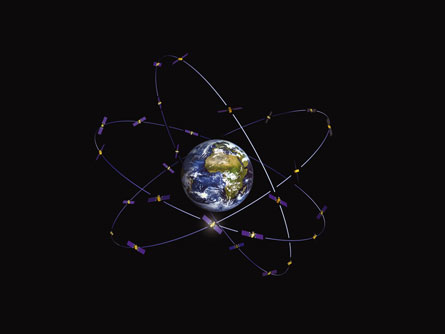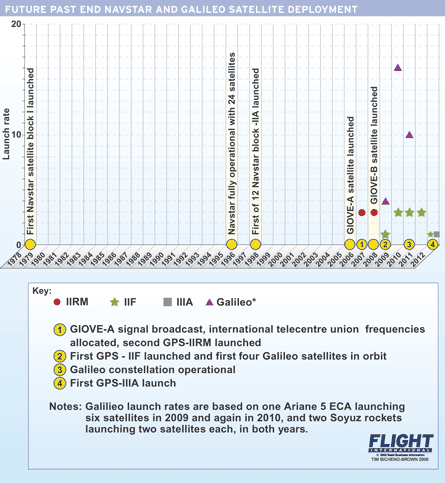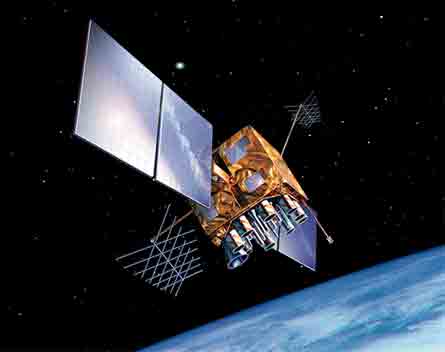In December the US military is expected to publish its next Navstar GPS spacecraft requirements. Meanwhile, Europe's Galileo satellite navigation system's second test craft is to go into orbit in early 2007
Although governments are pushing forward global navigation satellites services (GNSS), doubts remain that the aviation industry really needs it or wants it. And what will be delivered to aid flight operations and by when?
 |
|---|
Galileo consists of three planes with 10 satellites each |
While there has been controversy, largely in the UK press, about Galileo's alleged challenge to the hegemony of the US military's Navstar and the involvement of communist China in Europe's GNSS project, the USA and the European Union have been co-operating on satellite navigation and ground-based sister services since the 1990s. The promise of the GNSS projects is to fulfil the International Civil Aviation Organisation's (ICAO) dream of a seamless global navigation system with Category 1, 2 and 3 equivalent localiser performance with vertical-guidance (LPV) approaches at any airfield with the related augmentation systems.
Fully implemented, GNSS could enable governments to eventually strip out the current aviation-only navigation infrastructure and use these satellite services, the long-term costs for which can be shared with other methods of transport - trains, cars, ships - and even mobile telephone location-based service providers.
For aviation, the new infrastructure that could deliver Cat 1, 2 and 3-like services without instrument landing systems (ILS) consists of satellite-based augmentation systems (SBAS) and ground-based augmentation systems.
US systems
The SBAS and GBAS in the USA consist of the Wide Area Augmentation System, declared operational in 2003, and the Local Area Augmentation System, which is still in development.
"WAAS is already providing [en-route navigation and Cat 1 equivalent services across the USA]," says the father of GPS navigation, Stanford University's emeritus professor of aeronautics and astronautics, Bradford Parkinson.
There are more than 50,000 WAAS receivers in use in the USA, manufactured by navigation and communication equipment producers such as Garmin International. India, Japan and Russia are all developing their own versions of SBAS, with the systems from India and Japan expected to augment Navstar, as will Europe's European Geostationary Navigation Overlay Service (EGNOS) (see box) when it is fully operational in 2007.
However, in the future EGNOS could have the potential advantage of using both Navstar and Galileo. This could make the service more accurate and reliable because the increased number of satellites, signals and error correction data sent to the receiver.
Galileo in place
The €3.4 billion ($4.35 billion) 30-satellite constellation Galileo navigation system could be in place by 2010 (see chart).
The first four satellites should be in the constellation's 23,000km (14,280 miles) orbit in 2008 for testing. They are provided by the European Space Agency under the GNSS development agreement between ESA and its fellow Galileo investor the European Union.

"At the end of 2008 we expect two Soyuz launches, possibly from Kourou in French Guiana, with two Galileo satellites each," says ESA's head of navigation Didier Faivre. ESA and the EU expect 120,000 aircraft to use satellite navigation under international aviation standards by 2020.
The constellation's other 26 spacecraft, built by European joint venture Galileo Industries, will be the responsibility of Galileo's operator, European syndicate Merged Consortium.
Galileo's 30 spacecraft will be in three groups of 10 in three orbital planes, all at 23,000km altitude. Galileo is to be interoperable with Navstar.
In December last year Galileo's first test satellite, Galileo In-Orbit Validation Element (GIOVE-A), developed and built by the UK's Surrey Satellite Technology company, was successfully launched and in January it transmitted its first signals.
Ultimately, Galileo will transmit 10 navigation signals, four of which are encrypted for commercial and government use (see box). They will be used for Galileo's Open, Safety-of-life, Commercial and Public regulated-services.
The second Galileo test satellite, GIOVE-B, was to have been launched in April, but lift-off will now be next year, on a Russian Soyuz rocket from Baikonur, Kazakhstan. Galileo's developers say the service from their constellation will provide better accuracy and reliability than today's Navstar.
Accuracy is dependent upon the atomic clocks' performance, signal structure and position error correction methodologies.
If Galileo's constellation is operational after 2010 it will be orbiting the Earth along with the Navstar GPS-IIFs and the first GPS-IIIA. The GPS-IIIA's specification, the latest Navstar spacecraft, is to be published in December and it may specify capabilities that mean WAAS, and therefore EGNOS, are not needed.
"GPS-IIIA may enable unaugmented operations in the terminal area," says the US Federal Aviation Administration's director of navigation services Daniel Seldano.
However, 24 GPS-IIIA satellites would be needed for the accuracy and reliability required for aviation and this number may not be in orbit until the 2020s.
In future, to access the new capabilities of the GPS-IIR-M and GPS-IIF satellites, existing Navstar users will have to purchase new receivers, but these will also be back compatible.
Despite media claims of UK government department resistance to Galileo, the UK Ministry of Defence says that it "might have to buy Galileo receivers [due to future changes to the international convention] for safety of life at sea", to comply with rules for radio technology for life vests and rafts.
Bureaucratic confusion
In Europe, bureaucratic confusion could be a stumbling block to EGNOS's use in aviation. The SBAS airborne receiver's certification is the responsibility of the European Aviation Safety Agency (EASA), and that organisation already has standards for EGNOS. With EGNOS six months away from being declared fully operational, nobody has yet asked EASA to certificate an EGNOS receiver and certification of the EGNOS service presents a complicated problem.
"Getting certification is difficult because we're trying to figure this stuff out and it's tough because it's multinational," says Eurocontrol's Experimental Centre's communications, navigation and surveillance research area manager Richard Farnworth, who is involved in EGNOS validation.
EGNOS will operate within the framework of the new European Single Sky legislation. Current thinking is that it will be certificated by the national aviation authority in the country in which the service's operator, Merged Consortium, is legally based.
Merged Consortium's interim chief executive Jean-Francois Bou was not available for comment, but consortium member Inmarsat's navigation services manager Claudio Soddu says the timing for certification is "not really well defined, the roadmap is not really laid down". Merged Consortium may want to subcontract the EGNOS operation to European Satellite Services Provider (ESSP), the company created by Europe's national air traffic management organisations and operating EGNOS today.
Ahead of the game
Some national air traffic management organisations have been more proactive than others in developing EGNOS Cat 1-equivalent LPV approach information. The French and the Spanish are ahead of the game in starting to publish their information this year.
Despite the thorny certification situation, the Europeans believe the performance of EGNOS will be better than WAAS "because the ranging and integrity monitoring stations [RIMS] are closer together", says Farnworth.
 |
|---|
The second of Lockheed Martin's GPS-IIR-M satellites is being launched this week |
If the future of air travel is to be many small aircraft making short-haul trips between many small airfields, then GNSS, SBAS and GBAS make a lot of sense. However, the Association of European Airlines (AEA), International Air Transport Association and European Regions Airline Association oppose having to help fund systems such as EGNOS.
"Our point is that it does not provide any additional benefit for commercial airliners, which use en-route GPS navigation, inertial reference systems and inertial navigation systems," says the AEA. "EGNOS can of course be installed and operated. Our members wouldn't be opposed to this - as long as airlines do not have to pay for installation and operation."
That explains why none of the airlines or their aircraft suppliers has requested certification of an EGNOS receiver. AEA instead points to future enhanced vision system technology to support precision landing in a more cost-effective way.
Today, the US FAA is trying to solve technical problems to provide Cat 2 and 3-equivalent services to terminals at airfields in future using SBAS and GBAS.
"We haven't solved all the Cat 2 and 3 three issues," says Seldano.
There are no plans to deliver Cat 2 and 3 with EGNOS, although GBAS experiments are being conducted by airports at Bremen, Malaga, Milan and Zurich. Beyond the FAA and pan-European research work, there is no clear timetable for Cat 2 and 3 GBAS services anywhere in the world.
The EGNOS partners have instigated studies to decide if the service can be improved with different combinations of Navstar, Galileo or its 34 RIMS.
European technology company Vega is proposing work with the Technical University of Darmstadt on terminal area use of a combined Galileo/Navstar service. "Vega and Darmstadt are now in discussionsto bring in a simulated Galileo alongside GPS and EGNOS [for terminal operations] and expect to start work on this before the end of this year," says Vega's German subsidiary's managing director John Lewis.
And if the European studies find that EGNOS can work well enough for aviation's purposes without Galileo, would European governments accept that?
Off the record, a senior manager involved in European navigation system development says wryly: "We live with political decisions all the time." ■
Source: Flight International
















